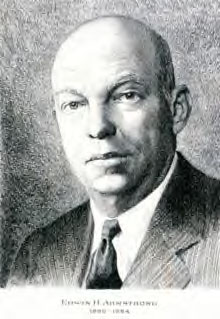
Welcome to the Tesla Memorial Society of New York Website
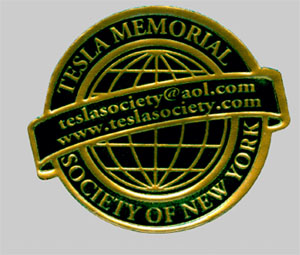
Nikola Tesla's Connection to Columbia University by Professor James Corum
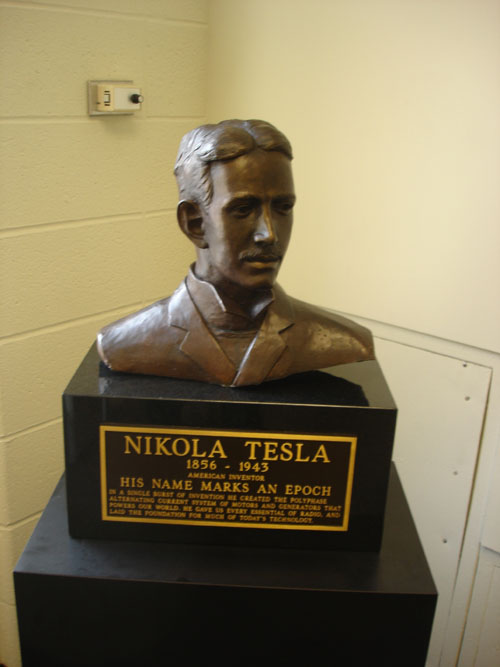
Above: Nikola Tesla Bust in Columbia University, donation of John Wagner.
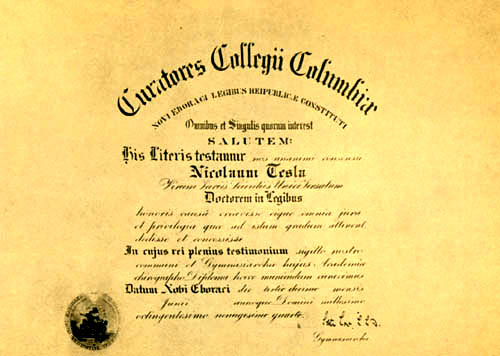
Above: Tesla Diploma of honorary Doctor of Collegium Columbiae (June 1894)
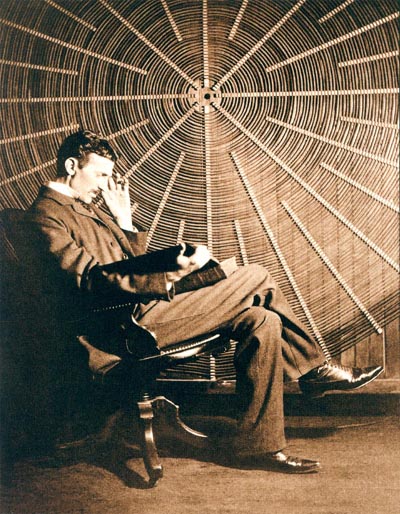
Above: Nikola Tesla, with Roger Boskovich's book "Theoria Philosophiae Naturalis", in front of the spiral coil of his high-frequency transformer at East Houston St., New York
Tesla’s Connection to Columbia University
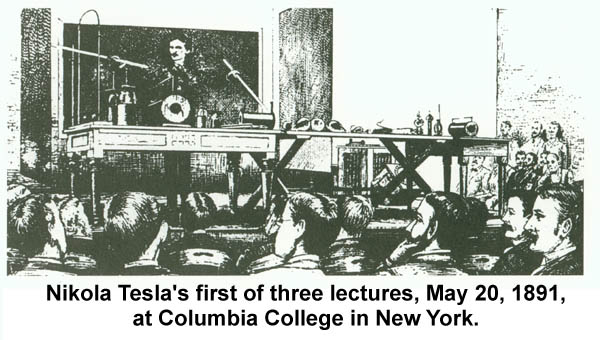
Introduction by Tesla Memorial Society of New York:
Distinguished American scientist, writer, educator, Dr. James R. Corum, an expert on Tesla's work and life, wrote this article for our website, www.teslasociety.com to shed some light on Tesla's activities in Columbia University. Tesla had several lectures at Columbia University on 1888, 1891,1893. With those lectures he announced a new era in the utilization of alternating current electricity and induction motor, and also, the high frequency, high voltage electricity. Both types of electricity are used today to make our lives better and to provide communication between nations and continents. With his lectures at Columbia University, Tesla changed the electrical engineering department in Columbia University and made the 20th century possible with its progress in electricity and communication. The 20th century is the electro-magnetic century. With his lectures he gave Columbia University prominences over other institutions in the world. The Tesla Memorial Society of New York is grateful to Dr. James Corum for this important article.
-Dr. Ljubo Vujovic, Secretary General, Tesla Memorial Society of New York
Tesla’s Connection to Columbia University
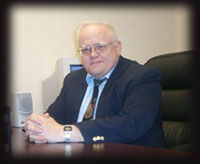
by
Dr. James F. Corum, Ph.D., June 12, 2005.
“The invention of the wheel was perhaps rather obvious; but the invention of an invisible wheel, made of nothing but a magnetic field, was far from obvious, and that is what we owe to Nikola Tesla.” Professor Reginald Kapp, 1956
INTRODUCTION
The Electrical Engineering curriculum at Columbia University, though not the first in the US, is one of the oldest and most respected programs in the world. From the beginning, a conscientious effort was made to base it on a foundation of science. It has been guided by the philosophy stated by Professor Michael Pupin, “Professor Crocker and I maintained that there is an ‘electrical science’ which is the real soul of electrical engineering.”
Arguably the most stunning and significant lecture in modern history was presented one spring evening more than a century ago at Columbia University. The wealth of nations turned on its outcome. Weighing on the balances would be our vast cities, civilization, and quality of life. It was Tesla’s great discovery of the rotating magnetic field and a means for the electrical distribution of energy.
Charles F. Scott, past President of the AIEE has said, “The evolution of electric power from the discovery of Faraday to the initial great installation of the Tesla polyphase system in 1896 is undoubtedly the most tremendous event in all engineering history.”
Assembled in that Columbia lecture hall were not only members of the academic world, with representatives from Columbia, Cornell, MIT, Yale and Johns Hopkins, but also the giants of industry from Westinghouse, Edison and General Electric, and also delegates from various trade journals, which soon spread the news of this great discovery.
In the same Columbia University atmosphere, three years later, in 1891, Tesla would present his discoveries in the realm of high frequency engineering and demonstrate the principle of coupled tuning. He would announce and demonstrate a technology that would raise the average power developed by RF sources five orders of magnitude! Such a remarkable innovative feat has never been repeated.
[There was also a third New York Lecture, though not presented at Columbia. It was delivered on April 6, 1897 at the New York Academy of Sciences, and it concerned high power RF apparatus, x-ray production, and new frequency measurement techniques.]
SPECIFIC LINKS BETWEEN TESLA AND COLUMBIA UNIVERSITY
There are at least three links to Tesla from Columbia University.
1. Conferral of an Honorary LL.D. by Columbia.
It was Professor Henry Fairfield Osborn, Dean of the Faculty of Pure Science, at Columbia, who ushered the recommendation of Nikola Tesla for an honorary doctorate degree. From the Columbia University archives we have:
“Dean Osborn wrote to college President Seth Low in January 1894, saying in part,
‘I have especially upon my mind two matters which I think will appeal to you very strongly. The first is connected with Mr. Hill of Nyack, and the second with Mr. Tesla of New York. I have learned recently that Mr. Hill is considered the leading mathematician in this country, and there seems to be little doubt that Mr. Tesla is the leading electrician. They are both, in a measure, connected with Columbia through Mr. Hill’s lectures here, and through the fact that Mr. Tesla, at Professor Pupin’s and Professor Crocker’s invitation, gave his first electrical lecture in Columbia. So, we have already established a sympathetic relation with these great men. I spent an afternoon recently with Tesla, and regard him as one of the most distinguished men I have ever met. I happened to meet Professor Crocker shortly afterwards, and learned from him that he had spoken to you in regard to giving Tesla an Honorary Degree. I would like to support this in the most earnest manner. Poulton (Professor of Biology at Oxford) tells me that Tesla was covered with honors while in England and France. We certainly must not allow any other University to anticipate us in honoring a man who lives under our very walls.’
In response to this, President Seth Low recommended, in a letter to the Trustees, dated February 5, 1894, that the honorary degree of LL.D. should be conferred on Nikola Tesla.
(Source: Columbia University Archives)”
[Quoted from: Nikola Tesla On His Work with Alternating Currents, by L.I. Anderson, Sun Publishing, 1992, reprinted by Twenty-First Century Books, 2002, footnote on pg. 71.]
Tesla received the “Doctorem in Legibus” honor on June 13, 1894. [See: Electrical Engineer, NY, June 20, 1894, p. 540] Indeed, Columbia has the honor of being the first university to so recognize Dr. Tesla. Honorary doctorates were subsequently conferred upon Tesla by more than a dozen other universities in Europe and in the US. [Columbia, Yale, Paris, Vienna, Sofia, Poitiers, Graz, Beograd, Brno, Bucharest, Grenoble, Zagreb, Prague, etc.]
But, the bond to Columbia goes even deeper than the University’s recognition of his distinguished contributions to science and civilization.
2. Tesla’s Lectures at Columbia.
Tesla presented at least two lengthy papers at AIEE meetings held on the Columbia University campus, as well as being present at many more. (We can read his questions in the meeting discussions published in the Transactions of the AIEE from that period, and Tesla was elected to serve for two years as Vice-President of the AIEE: 1892-1894.)
A. “A New System of Alternate Current Motors and Transformers,” presented before the AIEE at Columbia University on May 16, 1888. [See Transactions of the AIEE, Vol. 5, 1888, pp. 305-324.]
B. “Experiments with Alternate Currents of Very High Frequency and Their Application to Methods of Artificial Illumination,” presented before the AIEE at Columbia University on May 20, 1891. [See: Electrical World, Vol. 18, No. 2, July 11, 1891, pp. 19-27.]
3. Tesla’s Influence upon Columbia, Her Sons, and Her Community.
The Electrical Engineering Department at Columbia was established as a two-year graduate program 1889, with two faculty members: Professor Francis Bacon Crocker and Professor Michael Idvorsky Pupin. Subsequently, the four-year undergraduate BSEE program was instituted in 1892.
Columbia’s First Electrical Engineering Faculty:
Professor Francis Bacon Crocker (BS, Columbia, 1882; President of the AIEE, 1889)
We see from Dean Osborn’s January, 1894 comments above that it was Professor Crocker’s desire to honor Tesla, and it was his earlier conversation with President Seth Low that initiated the honorary degree process.
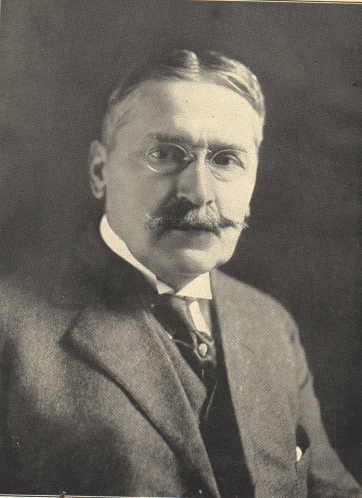
Above: Michael Idvorsky Pupin (1854 -1935)
Professor Michael I. Pupin (BS, Columbia, 1883; Ph.D., Berlin, 1889; Pulitzer Prize, 1924; President IRE, 1917; President AIEE, 1925)
“If there is anything in this world that I profoundly believe, it is certainly one thing and that is, that the credit of showing the practical importance of AC for motors belongs entirely to Tesla.” Letter dated Dec. 19, 1891.
Famous Columbia Students:

Above: Robert Millikan, one of Pupin's students.
Robert A. Millikan, (Ph.D., Columbia, 1895; Nobel Prize, 1923):
“When I was a young man of twenty-five, as a student in Columbia University, I attended [one of your] lectures. . . . it is not merely my congratulations that I am sending to you now, but with them also my gratitude and my respect in overflowing measure.” Letter to Tesla, May 30, 1931.

Above: John Stone Stone
John Stone Stone (Columbia University School of Mines; President, IRE, 1915)
“Tesla did more to excite interest and create an intelligent understanding [of RF] than anyone else. … [Tesla was] a man who we are now compelled, in the light of modern experience and knowledge, to admit was a prophet. . . [He] was so far ahead of his time that the best of us then mistook him for a dreamer.” [Ref. “Minutes of the Annual Meeting of the AIEE, May 18, 1917 – at the presentation of the Edison Medal to Nikola Tesla”]
Above: Edward Armstrong - developed and advanced the utility of FM technology.
Edwin Howard Armstrong (BSEE, Columbia, 1913):
“I believe that the world will wait a long time for progress and imagination equal to Tesla’s.”

Above: Gano Dunn, Pupin's student.
Gano Dunn (received the first EE degree granted by Columbia, 1891; D.Sc. (honorary), Columbia University; Columbia University Alumni Egleston Medal, 1939; President AIEE, 1912)
“Tesla solved the greatest problem in electrical engineering of his time. . . . My contact as [Tesla’s] assistant at the historic Columbia University high frequency lecture and afterward, has left an indelible impression and an inspiration which has influenced my life.” July, 1931.
Both Professor Armstrong and Dr. Dunn later served as pallbearers, in January of 1943, at Dr. Tesla’s funeral at the Cathedral of St. John the Divine in NYC.
Columbia Researchers:
Professor Felix Ehrenhaft (Director of the Physics Institute at the University of Vienna; who also operated a visiting Research Lab at Columbia)
Professor Ehrenhaft, who had nominated Albert Einstein for the Nobel Prize in 1921, also nominated Dr. Nikola Tesla for an undivided Nobel Prize in Physics in 1937.
[Ref.: The Nobel Population 1901-1937: A Census of the Nominators and Nominees for the Prizes in Physics and Chemistry, by E. Crawford, J.L. Heilbron, and R. Ulrich, University of California, 1987.]
CONCLUSION
It was a wonderful thing that Tesla openly published and shared his electrical discoveries with the professional, scientific, industrial and academic communities in the US, England, France and Germany. We are, indeed, fortunate that so many of these lectures on energy conversion devices, power transmission, RF tuning, high voltage engineering, and fundamental electrical phenomena have been preserved and are still available today. A century ago Lord Kelvin was moved to say, “Tesla has contributed more to electrical science than any man up to his time.”
Several years ago, on August 14, 2003, New York City experienced a dramatic electrical blackout. The event can be viewed as a demonstration of where the twentieth century would have taken us, and where modern civilization would be, without Tesla’s wonderful discovery of the rotating magnetic field and the vast technologies which it made possible.
Prophetically, at the Edison Medal presentation ceremony in New York City, the Vice-President of the AIEE (now IEEE) said,
“Were we to seize and to eliminate from our industrial world the results of Mr. Tesla's work, the wheels of industry would cease to turn, our electric cars and trains would stop, our towns would be dark, our mills would be dead and idle. . . It is particularly pleasing to me to pay my tribute to the inventor of the motor and the system which have made possible the electric transmission of energy.” (Dr. Bernard A. Behrend, May 18, 1917)
Viewing the wonders wrought by electricity, Professor John D. Kraus of Ohio State University has called the twentieth century the “Electromagnetic Century”.
It is satisfying to know that this scientific genius and great benefactor to modern civilization, Nikola Tesla, was recognized, honored, and encouraged by Columbia University’s talented scientific community. Furthermore, the world at large owes a debt of gratitude to Columbia and to the IEEE for fostering and encouraging such scientific forums.
